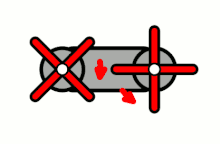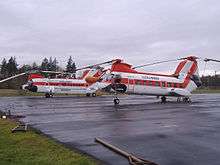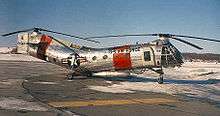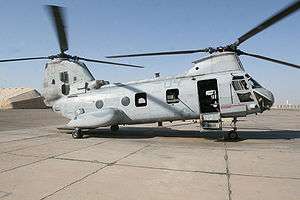Tandem rotors
Tandem rotor helicopters have two large horizontal rotor assemblies mounted one in front of the other. Currently this configuration is mainly used for large cargo helicopters.[1]

Single rotor helicopters need a mechanism to neutralize the yawing movement produced by the single large rotor. This is commonly accomplished by a tail rotor, coaxial rotors, and the NOTAR systems. Tandem rotor helicopters, however, use counter-rotating rotors, with each cancelling out the other's torque. Therefore, all of the power from the engines can be used for lift, whereas a single rotor helicopter uses some of the engine power to counter the torque.[1] An alternative is to mount two rotors in a coaxial configuration. The first successful tandem rotor helicopter was built by Nicolas Florine in 1927.
Advantages of the tandem-rotor system are a larger center of gravity range, and good longitudinal stability. Disadvantages of the tandem-rotor system are a complex transmission,[1] and the need for two large rotors.
The two rotors are linked by a transmission that ensures the rotors are synchronized and do not hit each other, even during an engine failure.[2]
Tandem rotor designs achieve yaw by applying opposite left and right cyclic to each rotor, effectively pulling both ends of the helicopter in opposite directions. To achieve pitch, opposite collective is applied to each rotor; decreasing the lift produced at one end, while increasing lift at the opposite end, effectively tilting the helicopter forward or back.[3]
Tandem rotor helicopters have the advantage of being able to hold more weight with shorter blades, since there are two sets. However, the rear rotor works in the aerodynamic shadow of the front rotor, which reduces its efficiency. This loss can be minimized by increasing the distance between the two rotor hubs, and by elevating one hub over the other.[4][5] Tandem rotor helicopters tend to have a lower disk loading than single rotor helicopters.[6]
Tandem rotor helicopters typically require less power to hover and achieve low speed flight as compared to single rotor helicopters. Both configurations typically require the same power to achieve high speed flight.[7]
List of tandem rotor helicopters


- Bell HSL (1953)
- Boeing CH-47 Chinook (1961) - most-produced tandem-rotor helicopter (over 1,200 built)
- Boeing Model 360 (1987)
- Boeing Vertol 107-II (1958)
- Boeing Vertol CH-46 Sea Knight (1960)
- Boeing Vertol XCH-62 (1970s - not completed)
- Boeing Vertol Model 234 (1981)
- Bristol Belvedere (1958)
- Bristol Type 173 (1952)
- Chu CJC-3 (1952)
- Filper Beta 200 (1966)
- Filper Beta 400 (1967)
- Filper Helicopter (1965)
- HERC JOV-3 (1948)
- Jovair Sedan 4A (1963)
- McCulloch MC-4 (1951)
- Piasecki H-16 (1953)
- Piasecki H-21 (1949)
- Piasecki H-25/HUP Retriever (1952)
- Piasecki HRP Rescuer (1945)
- Piasecki PV-14 (1948)
- Rotorcraft XR-11 (1947)
- Yakovlev Yak-24 (1952)
References
- "Archived copy". Archived from the original on 2014-02-18. Retrieved 2017-12-03.CS1 maint: archived copy as title (link)
- Art of the helicopter by John Watkinson, p. 13
- "US Army FM 3-04.203 Fundamentals of Flight; page 1-33, para 1-81, 1-82" (PDF).
- Principles of helicopter aerodynamics by J. Gordon Leishman p. 73.
- Rotary Wing Aerodynamics, W.Z. Stepniewski, p. 197.
- Rotary Wing Aerodynamics, W.Z. Stepniewski, p. 185
- Rotary Wing Aerodynamics, W.Z. Stepniewski, p. 200.

.jpg)